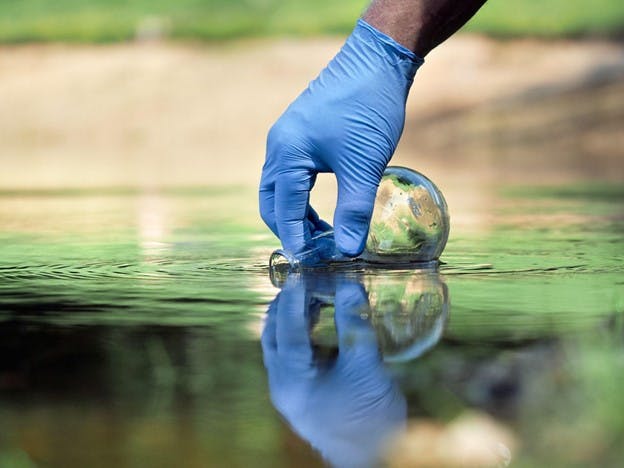November 2023
Columbus Water Quality: What We Discovered in Your Water
If you were to ask people born outside the U.S. to name major American cities, Columbus, Ohio might not immediately come to mind. But that's rapidly changing.
The city of Columbus is one of the Midwest's fastest-growing urban hubs, having welcomed over half a million newcomers in just the past two decades. The city has become a magnet for a diverse group of highly educated young adults, who are attracted by its innovative entrepreneurial policies and the 21 Fortune 1000 companies that call Columbus home.
From emerging as a leader in smart city technologies to having a booming fashion industry and award-winning restaurants, Columbus is not-so-quietly advancing America forward.
But as Columbus grows, so do its infrastructure challenges. In particular, its ability to deliver clean, healthy water to every Columbusite who needs it.
In this article, we’re taking a deep dive into Columbus water quality. We want to see where your water comes from, what’s in it, and find out if Columbus water is safe to drink for you and your family.
Where Does Columbus Tap Water Come From?
Columbus, Ohio’s capital city, is rich in water resources. It was strategically built between the Scioto River and Olentangy River. These surface water systems exclusively supplied this growing town with water from 1870 to the 1960s.
In 1908, the city dammed up part of the Scioto River to the north to create the Griggs Reservoir. By 1925, the dam system was expanded by creating the O’Shaughnessy Reservoir. Together these two reservoirs could serve half a million people, or twice the Columbus population at the time.
Within 20 years though, the city’s rapid growth caught up with city planners who had to start building again. By 1955, they dammed off Big Walnut Creek to create the Hoover Reservoir. And then in the late 1960s, the city made its latest water moves when it dug four Ranney Collector Wells in southern Franklin County.
Today, Columbus provides 130 million gallons of water per day to citizens and it can store up to 27 billion gallons of water between the Griggs, O'Shaughnessy, and Hoover reservoirs. The three reservoirs supply 85% of the city’s drinking water while groundwater from the Ranney Collector Wells covers the other 15%.
These reservoirs also provide the city’s residents and visitors with summer recreation like boating, swimming, fishing, and more.
How Is Columbus Water Quality?
Ohio has a history of water quality problems. In fact, it was the 1969 Cuyahoga River fires just a few hours away from Columbus that spurred on the creation of the U.S. Environmental Protection Agency (EPA), the Clean Water Act, and the Safe Drinking Water Act (SDWA), which now governs the entire nation’s drinking water.
It was only a little over 50 years ago when Time Magazine described the Cuyahoga River as oozing rather than flowing. Unfortunately, the Scioto River wasn’t faring much better. After a 150-year period of pollution caused by sewage and dumping, the efforts to clean it up with advanced wastewater treatment plants are starting to pay off. More species of fish and macroinvertebrates are starting to come back as the watersheds are better cared for. In fact, 86% of Ohio rivers are no longer impaired.
Is It Safe to Drink Tap Water in Columbus, Ohio?
According to the Columbus Water Quality Report and the U.S. Environmental Protection Agency (EPA), Columbus tap water is safe to drink. It’s important to note, however, that meeting regulatory standards doesn’t always mean water is safe.
Currently, the U.S. EPA regulates about 90 water contaminants but there are thousands of potential contaminants that we know very little about. Some, like microplastics, we’ve found in water supplies all over the world, but they aren’t regulated in drinking water since testing for them is extremely challenging and expensive,
Water safety standards are a balancing act between protecting public health and keeping water treatment affordable for public utilities and their customers. If it costs too much to remove a contaminant from the water supply, higher limits may be allowed.
This may be why the Environmental Working Group (EWG), a D.C.-based water watchdog, says EPA regulation doesn’t always keep up with science. In fact, the last update to water regulations was almost 20 years ago, even though our understanding of many contaminants has changed.
What Is in Columbus Tap Water?
While the annual consumer confidence report (CCR) says Columbus water quality meets all legal requirements, there are a few pollutants that are deemed too high by the Environmental Working Group.
Many of these are disinfection byproducts that come from the treatment methods used in Columbus’ water distribution system. Here’s a list of contaminants found in Columbus water.
Haloacetic Acids (HAA5)
HAA5 is made up of five haloacetic acids: monochloroacetic acid, dichloroacetic acid, trichloroacetic acid, monobromoacetic acid, and dibromoacetic acid. These chemicals are known as disinfection byproducts, as they result from disinfectants like chlorine interacting with organic matter in water. Long-term exposure to HAA5 can lead to cancer.
Levels of HAA5 in Columbus water have exceeded what the EWG recommends for safety by 299 times:
- EPA maximum allowance: 60 parts per billion (ppb)
- EWG recommended maximum: 0.1 ppb
- Columbus maximum contaminant level: 29.9 ppb
Haloacetic Acids (HAA9)
HAA9 includes all of the contaminants from HAA5 but adds bromochloroacetic acid, bromodichloroacetic acid, chlorodibromoacetic acid, and tribromoacetic acid. These are also disinfection byproducts and are also cancer-causing.
Levels of HAA9 in Columbus water have exceeded what the EWG recommends for safety by 364 times:
- EPA maximum allowance: No legal limit
- EWG recommended maximum: 0.06 ppb
- Columbus maximum contaminant level: 21.8 ppb
Total Trihalomethanes (TTHMs)
TTHMs — like the haloacetic acids above — are formed when chlorine interacts with organic compounds in drinking water. They’re also known to be carcinogenic. This category is made up of four chemicals: chloroform, bromodichloromethane, dibromochloromethane, and bromoform.
Levels of TTHMs in Columbus water have exceeded what the EWG recommends for safety by 275 times:
- EPA maximum allowance: 80 ppb
- EWG recommended maximum: 0.15 ppb
- Columbus maximum contaminant level: 41.3 ppb
Chromium (Hexavalent)
Chromium is another common contaminant found in U.S. water supplies. It can occur naturally but is also an industrial pollutant. Although it’s known to be a carcinogen, this contaminant is still unregulated by the EPA.
Chromium levels in Columbus water have exceeded what the EWG recommends for safety by 10 times:
- EPA maximum allowance: No legal limit
- EWG recommended maximum: 0.02 ppb
- Columbus maximum detected level: 0.207 ppb
Nitrates
Nitrates usually end up in water supplies through stormwater runoff from fertilizers, but they can also come from septic tanks. They can cause oxygen deprivation in infants and increase the risk of certain cancers.
Nitrate levels in Columbus water have exceeded what the EWG recommends for safety by 20 times:
- EPA maximum allowance: 10 parts per million (ppm)
- EWG recommended maximum: 0.14 ppm
- Columbus maximum detected level: 2.86 ppm
Does Columbus Water Have Chlorine?
Yes. Columbus water quality is kept high through a variety of treatment methods including disinfecting with ozone, UV light, and chlorine. Chlorine and chloramines are used as either a primary or secondary disinfectant in most developed cities worldwide.
While the amounts of chlorine used can cause your water to taste a little off and create disinfection byproducts, their use eliminates more health risks than they create. You can easily improve your drinking water quality by filtering chlorine out of your water.
Columbus also adds additives to prevent pipe corrosion and fluoride for dental health.
Is Columbus City Water Hard or Soft?
Columbus has hard water, but the Columbus Division of Water is rare in that it does remove some of the hard water minerals before it's sent to customers. Because of this, some Columbusites may actually get soft water depending on where your water gets treated.
Water hardness is a measure of dissolved hard water minerals like calcium and magnesium in your water. The higher concentration your water has, the harder your water is. While it’s not unsafe to ingest hard water minerals, they can wreak havoc on your home and skin.
Minerals not only stain surfaces and make them hard to clean but they also build up in pipes, create soap scum, and make your water using appliances less efficient. If you have hard water, using a traditional water softener or salt-free water conditioner will change your life.
Is Columbus City Water Fluoridated?
Yes. Like most major cities in the United States, Columbus adds fluoride to their tap water as a public health initiative. Fluoride is known to strengthen tooth enamel and prevent dental cavities in children and adults.
There are some concerns about fluoride causing dental fluorosis, or brown tooth discoloration, if ingested by babies without fully formed teeth. Because of this and other reasons, many people would rather have more control over their fluoride use and intake. To filter fluoride out of your water, you have to use a reverse osmosis filtration system. Boiling water or using a standard activated carbon filter will not remove fluoride from water.
How You Can Get the Best-Tasting Water While Living in Columbus
Columbus has made great strides in improving their rivers and the drinking water that comes from them. However, with elevated levels of disinfection byproducts, nitrates, and chromium there’s still room for Columbus water quality to improve.
If you want only the best-tasting, highest quality water coming from your tap, HomeWater can help. Our UPSTREAM 4-Stage Whole Home Water Filter will deliver refreshingly clean water to every faucet in your home. It will remove contaminants like dirt, rust, chlorine, disinfection byproducts, nitrates, chromium, PFOS, microorganisms, and more. Add a salt-free water conditioner to get rid of that hard water for good.
With HomeWater, you can get superior water from every tap in your Columbus home.
Related Articles
November 2023
Avoiding the 9 Most Common Waterborne Diseases
November 2023
What Causes Smelly Tap Water and How Can You Fix It?
October 2023


